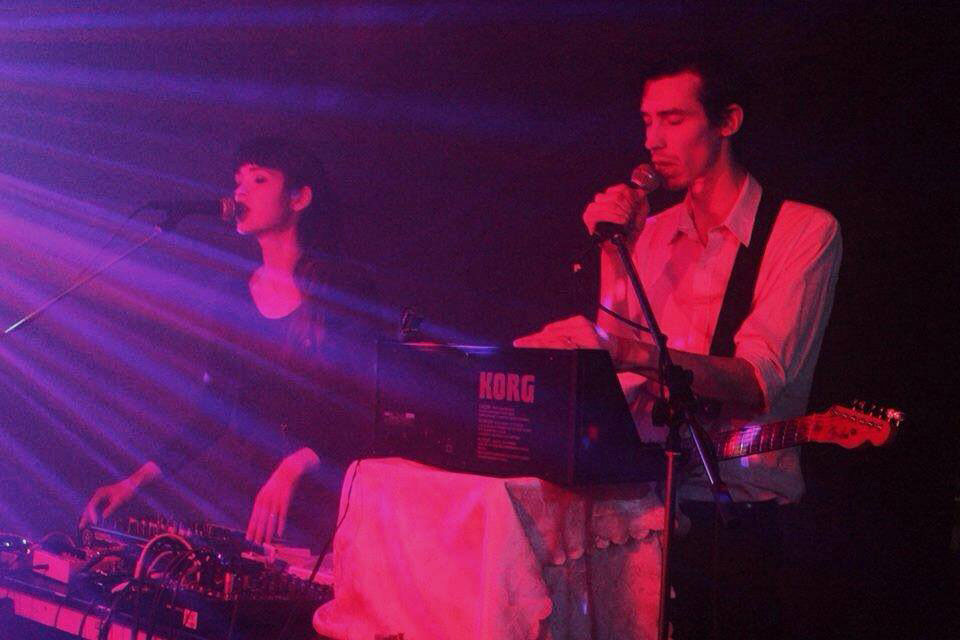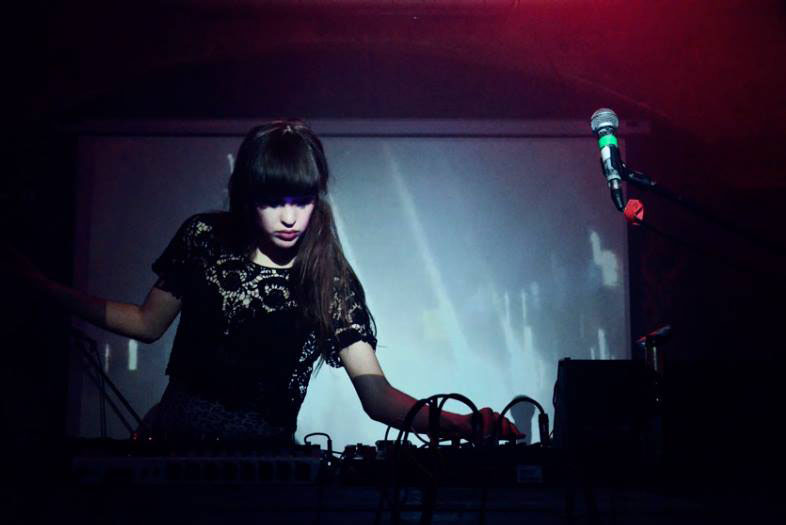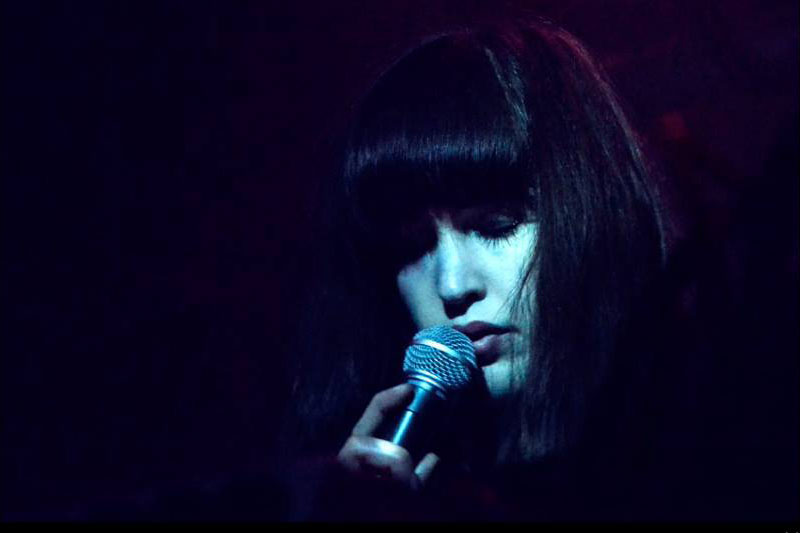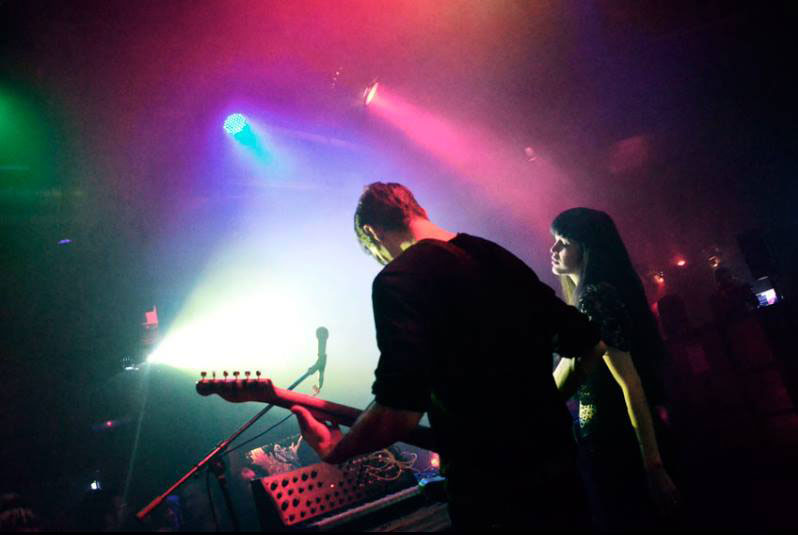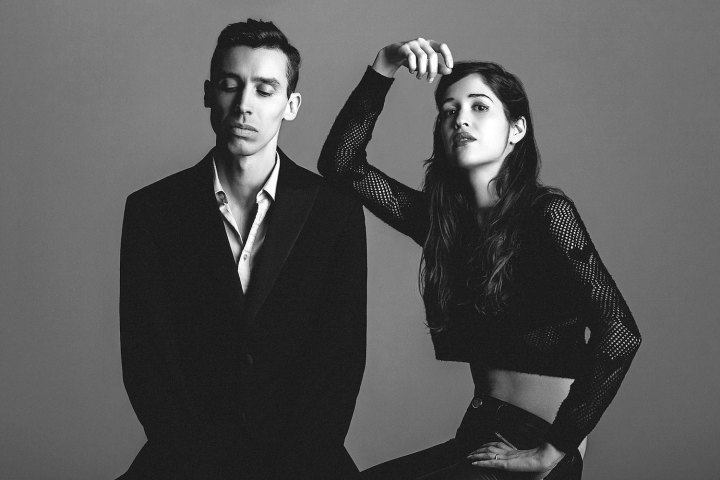
“I like that my sounds are open to interpretation.”
Sometimes, all it takes is two — or, in this case, make that deux, since we’re talking about the Montreal-based French-speaking electronic duo Essaie pas, whose name translates to either “Don’t Try” or “Try Not,” depending on how you look at it.
That’s not to say vocalist Marie Davidson and instrumentalist/producer Pierre Guerineau have a negative outlook on their work — pas du tout! Instead, they’re more in step with the Charles Bukowksi maxim “Don’t try… wait for it to come to you” on their modern/retro-cool hybrid new album Demain est une autre nuit, out now in various formats via DFA Records. “Yeah, it’s a positive thing,” concurs Guerineau. “And when you’re taking action, have no fear. Whatever you have to do, just do it.”
Guerineau and Davidson do it quite right all over Demain — the full title translates to Tomorrow Is Another Night in English — from the burbling siren charge of Retox to the Vital Signs-like synth pulse of Le port du masque est de rigeuer to the train station echoing in vain on Facing the Music. And though most of Essaie pas’ accompanying lyrical content is either spoken or sung in French, you don’t need to speak the language to be in touch with the album’s underlying sonic intent.
Guerineau and Digital Trends connecté via Skype recently to discuss the merging of modern and retro sounds, the merits of streaming (a.k.a. diffusion), and how to evolve studio arrangements onstage. Viva la Montreal!
Digital Trends: Did you record the music for Demain in high resolution at, say, 96/24?
Pierre Guerineau: I do it the best my computer can handle right now, which is 44.1/24. Usually that is good enough to have good-sounding effects. Especially for the reverbs, 24 bits made it sound better than when I was recording in 16 bits in the past. Hopefully, I can get a better computer at some point.
Tell me about the gear you’re using now — both the physical gear and the plug-ins.
It’s been changing, but for this album, we used the Korg MS-20 synthesizer a lot, and Marie actually had a Minimoog most of the time. We also used the MFB sequencer and lots of drum machines, like the Roland TR-505 and TR-707 [rhythm composers].

Right now, I’m using more Ableton Live, but for this album, I used Pro Tools. For me, Ableton Live offers some things Pro Tools cannot. I have an old version of Pro Tools and it costs so much money to stay up to date with those guys, so I decided to make the switch. I really love with Ableton how you can A/B the audio in the same way — you can go from one to another, and back and forth. It’s pretty well done.
Especially when using Maxwell Bass, there’s a sense of community. Everyone can build their own plug-ins and create their own tools that fit the way they want to work, you know? I think it’s great for the community.
On a song like Lights Out, it feels like we’re in a room with the keys, the percussion, and the synths, and then we get how they all fit together. Was that the goal for what you wanted to give us with some of these tracks?
Yes, definitely — especially for Lights Out, we do have a sense of space. Sometimes I like it to feel really close physically with the bass, yet at the same time make it feel as vast as possible, like being in an empty warehouse. Where we are practicing, we get that feel in the stairway.
I’m a big dub music fan too. It was revolutionary what those guys did to music. They used the sound and the effects to create another world. That is a big influence on my music.
Which dub artists stand out to you the most?
For me, King Tubby is the king. I really love Lee Perry and some of the others, but King Tubby is the one for me. And some of the producers from the U.K., like Mad Professor and his Dubbing With Anansi (2014) — so many great things to dig into.
Those guys invented the remix. They’d take a track and take the vocal apart, rework it, and mute the instruments. It’s modern music with great instrumentation.
Speaking of doing that, on Retox, you bring an ’80s minimalist feel to the modern era. Were the ’80s an influence on you as an artist?
It’s a balance of things — including a lot of Italo disco too, and those productions. I really love gated reverbs and sequencing. We really love those sounds. But it’s funny that you mention the sound quality of this one special track, because it was more lo-fi in the way we recorded it, almost like improv.
So that we wouldn’t forget the idea of it, we recorded straight from the board with the synth and the bass drum together in one track. We really liked that feel, so we decided to keep it that way. At the mix stage, we just added some vocals, some effects, and some strings at the end. It’s very digi-friendly, but we also have the feeling the new record will fit on the stereo as well.
I think it’s good for both vinyl and hi-res downloading myself. On the digital side, your album is also streaming on YouTube. Are you OK with people accessing your music that way?
Yeah, of course. I consume music like that sometimes. But for me, I find it really tiring to listen to streaming music after a while, so I’d rather buy a high-quality download or listen to the actual record.
But I do like the convenience, so sometimes I go to YouTube just to listen to music. It’s great to preview things; it’s wonderful. And if it’s something I want to listen to again and get more and more into, I will get the hi-fi version.
What do you listen to when you’re not making music yourself?
Ah, that’s a good question. We listen to a lot of ambient music, particularly at night. We listen to a lot of dance-oriented music during the day with beats, so at night, when we come back from the studio, we want to calm down. When you’re working on songs, you have all these sounds in your head, and it helps to clean it out. So, lots of ambient music.
Percussion and effects are very intricate on the last track La chute [The Fall], and I feel you’ll miss out on lot of the detail with a low-grade MP3.
Yes. Especially when people listen to laptop speakers. The highs and the vocals [makes grinding “whoosh” noise] — it’s pretty terrible.
Is that a surface-noise effect when the song is fading out?
Dub music uses sounds and effects to create another world.
At the end? [chuckles] It’s a sound I did with my MS-20, and some effects. It definitely has a nostalgic vibe. It’s like the same sound heard on the very first track of the album; they have similar aspects. Some people have told me it sounds like a film projector, some people have told me it’s like rain on a tarp, or an old record. I like that my sounds are open to interpretation. I don’t do sound designs. It’s just music
Speaking of effects, on Track 2, Dépassée par le fantasme, which I believe translates to Overtaken by Fantasy, how did you get those beginning, swirling stereo pans and the underwater vibe?
It was mostly reverse reverbs, mixed before the actual sounds come, and some panning effects. When we put the vocals through the reverbs, it was like, “yes!”
How do you and Marie set up your vocal interactions? Are they planned out, or do you just know by instinct who’s going to go where in any given song?
It depends on each song. Sometimes the music decides, like on La chute, where we thought it would fit better with me talking and Marie doing more “airy” sounds, like a fantasy, or [pauses] — I’m not sure of the word…
I see her there as more of an ethereal voice, responding to what you’re saying.
Ah, yes! And Retox is more like a dialogue, with two points of view on the same thing. Le port du masque est de rigueur [Wearing the Mask Is Required] is more about a man being obsessed, so Marie’s voice is always repeating the same phrase, as part of his obsession. She just says one word in a loop, like a loop of backing, female singers, talking a little bit differently. It really depends on each song.
I’m glad we’re getting this album on vinyl too. Did you grow up with vinyl? Is that your preferred listening medium of choice?
Yeah, I really love it, especially for the object of it — the thing is a beautiful object. But to be honest, I do listen to a lot in the digital medium as well. I think every format has pros and cons to them. But what I like about vinyl is the ritual of listening to one album — the A side, and then the B side. Our album was made with that in mind too.
Do you have a favorite album, or one that impacted you the most growing up?
Yeah, it was a cassette that my father had of the two first albums of The Doors back to back on it [The Doors and Strange Days, both released in 1967]. I used to listen to them on a loop, especially Break on Through [the opening track on The Doors] — that is like genius. It was one of the first things that made me want to do music.
When you say the name, “The Doors,” it also defines their sound, since no one else sounds like they do. And Ray Manzarek was a keyboard genius. I imagine he filtered into your influence palette.
Oh, I know; exactly. That band is so complementary, you know? They really band together, even when they go minimalist. The sound is sexy, it’s mystical — they’ve got it all.
And the live versions are sometimes better than the album ones, like When the Music’s Over [originally the last song on Side 2 of Strange Days]. It’s incredible. They’re definitely an influence on our music.
You’ve been on the road with this new album. Does your stage show go beyond what’s on the record?
It does always evolve a bit, especially if we want to integrate tools on the computer. It helps me do more stuff that I can carry. I don’t have a technical team who can carry all of my analog synths! It has to fit in my suitcase. You cannot bring three or four synths; you’ve got to make some choices.
So, we had to find the best way to work between analog machines and computers, and I think we found a very nice balance that works well for us. The computer helps with having every sound right there: “For this song, I need this sound.”
And the song choices will depend on where we play. Sometimes it’s more “club,” sometimes it’s more song-oriented. We still have fun interacting with the machines, so every night is different.
